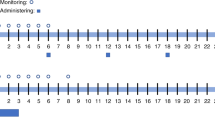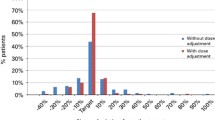Abstract
-
▲ An intravenous formulation of busulfan, a cytotoxic bifunctional alkylating agent, has been developed to replace oral busulfan as a conditioning treatment prior to hematopoietic stem cell transplantation (HSCT) in pediatric patients.
-
▲ Doses of intravenous busulfan based on actual body weight, but not age, reduce inter- and intraindividual variability in exposure.
-
▲ In a study of intravenous busulfan as a conditioning treatment prior to allogeneic or autologous HSCT, the majority of pediatric patients, who received one of five bodyweight-based doses, achieved busulfan area under the plasma concentration-time curve (AUC) values within the targeted therapeutic range.
-
▲ Although mean busulfan clearance values were highly variable between bodyweight strata, exposure was not affected, with no significant differences between bodyweight groups in mean AUC values.
-
▲ The achievement of therapeutic AUC values with intravenous busulfan resulted in a high rate of sustained engraftment, low transplant-related mortality, and promising survival outcomes post-transplant.
-
▲ Intravenous busulfan was considered to be well tolerated, in the particular context of HSCT, and no failure of HSCT due to organ toxicity was reported. Nonhematologic adverse events commonly associated with busulfan conditioning regimens were frequent, but generally of mild to moderate severity.
-
▲ The intravenous busulfan regimen was frequently associated with elevated liver enzymes, but hepatic veno-occlusive disease (HVOD) was infrequent, of mild to moderate severity, and resolved within 10 days of diagnosis. Unlike oral busulfan, intravenous busulfan does not appear to be associated with severe HVOD or death due to organ toxicity.


Similar content being viewed by others
Notes
The use of trade names is for product identification purposes only and does not imply endorsement.
References
Ljungman P, Urbano-Ispizua A, Cavazzana-Calvo M, et al. Allogeneic and autologous transplantation for haematological diseases, solid tumours and immune disorders: definitions and current practice in Europe. Bone Marrow Transplant 2006 Mar; 37(5): 439–49
Fisher VL, Barnes YJ, Nuss SL. Pretransplant conditioning in adults and children: dose assurance with intravenous busulfan. Oncol Nurs Forum 2006 Mar; 33(2): E36–43
Léger CS, Nevill TJ. Hematopoietic stem cell transplantation: a primer for the primary care physician. CMAJ 2004 May 11; 170(10): 1569–77
European Medicines Agency. Busilvex: European Public Assessment Report (EPAR) [online]. Available from URL: http://www.emea.europa.eu/humandocs/Humans/EPAR/busilvex/busilvex.htm [Accessed 2007 May 9]
McCune JS, Gibbs JP, Slattery JT. Plasma concentration monitoring of busulfan: does it improve clinical outcome? Clin Pharmacokinet 2000 Aug; 39(2): 155–65
Bouligand J, Boland I, Valteau-Couanet D, et al. In children and adolescents, the pharmacodynamics of high-dose busulfan is dependent on the second alkylating agent used in the combined regimen (melphalan or thiotepa). Bone Marrow Transplant 2003 Nov; 32(10): 979–86
Vassal G, Gouyette A, Hartmann O, et al. Pharmacokinetics of high-dose busulfan in children. Cancer Chemother Pharmacol 1989; 24(6): 386–90
Booth BP, Rahman A, Dagher R, et al. Population pharmacokinetic-based dosing of intravenous busulfan in pediatric patients. J Clin Pharmacol 2007 Jan; 47(1): 101–11
Rauh M, Stachel D, Kuhlen M, et al. Quantification of busulfan in saliva and plasma in haematopoietic stem cell transplantation in children: validation of liquid chromatography tandem mass spectrometry method. Clin Pharmacokinet 2006; 45(3): 305–16
Nguyen L, Fuller D, Lennon S, et al. I.V. busulfan in pediatrics: a novel dosing to improve safety/efficacy for hematopoietic progenitor cell transplantation recipients. Bone Marrow Transplant 2004 May; 33(10): 979–87
Vassal G, Michel G, Esperou H, et al. Prospective validation of a novel IV busulfan fixed dosing for paediatric patients to improve therapeutic AUC targeting without drug monitoring. Cancer Chemother Pharmacol Epub 2007 Mar 29
Vassal G. Pharmacologically-guided dose adjustment of busulfan in high-dose chemotherapy regimens: rationale and pitfalls (review). Anticancer Res 1994 Nov-Dec 31; 14(6A): 2363–70
Copelan EA, Bechtel TP, Avalos BR, et al. Busulfan levels are influenced by prior treatment and are associated with hepatic veno-occlusive disease and early mortality but not with delayed complications following marrow transplantation. Bone Marrow Transplant 2001 Jun; 27(11): 1121–4
Tran H, Petropoulos D, Worth L, et al. Pharmacokinetics and individualized dose adjustment of intravenous busulfan in children with advanced hematologic malignancies undergoing allogeneic stem cell transplantation. Biol Blood Marrow Transplant 2004 Nov; 10(11): 805–12
Vassal G, Koscielny S, Challine D, et al. Busulfan disposition and hepatic veno-occlusive disease in children undergoing bone marrow transplantation. Cancer Chemother Pharmacol 1996; 37(3): 247–53
Hassan M, Ljungman P, Bolme P, et al. Busulfan bioavailability. Blood 1994; 84(7): 2144–50
Ljungman P, Hassan M, Bekassy AN, et al. High busulfan concentrations are associated with increased transplant-related mortality in allogeneic bone marrow transplant patients. Bone Marrow Transplant 1997 Dec; 20(11): 909–13
Slattery JT, Sanders JE, Buckner CD, et al. Graft-rejection and toxicity following bone marrow transplantation in relation to busulfan pharmacokinetics. Bone Marrow Transplant 1995 Jul; 16(1): 31–42
Hassan M. The role of busulfan in bone marrow transplantation. Med Oncol 1999; 16(3): 166–76
Buggia L, Locatelli F, Regazzi M-B, et al. Busulfan. Ann Pharmacother 1994; 28(9): 1055–62
European Medicines Agency. Busilvex: summary of product characteristics [online]. Available from URL: http://www.emea.europa.eu/humandocs/Humans/EPAR/busilvex/busilvex.htm [Accessed 2007 May 9]
Grigg AP, McLachlan R, Zaja J, et al. Reproductive status in long-term bone marrow transplant survivors receiving busulfan-cyclophosphamide (120 mg/kg). Bone Marrow Transplant 2000 Nov; 26(10): 1089–95
Teinturier C, Hartmann O, Valteau-Couanet D, et al. Ovarian function after autologous bone marrow transplantation in childhood: high-dose busulfan is a major cause of ovarian failure. Bone Marrow Transplant 1998 Nov; 22(10): 989–94
Brachet C, Heinrichs C, Tenoutasse S, et al. Children with sickle cell disease: growth and gonadal function after hematopoietic stem cell transplantation. J Pediatr Hematol Oncol 2007 Jul; 29(7): 445–50
Hempel G, Oechtering D, Lanvers-Kaminsky C, et al. Cytotoxicity of dimethy-lacetamide and pharmacokinetics in children receiving intravenous busulfan. J Clin Oncol 2007 May 1; 25(13): 1772–8
Schechter T, Finkelstein Y, Doyle J, et al. Pharmacokinetic disposition and clinical outcomes in infants and children receiving intravenous busulfan for allogeneic hematopoietic stem cell transplantation. Biol Blood Marrow Transplant 2007 Mar; 13(3): 307–14
Zwaveling J, den Hartigh J, Lankester AC, et al. Once-daily intravenous busulfan in children prior to stem cell transplantation: study of pharmacokinetics and early clinical outcomes. Anticancer Drugs 2006 Oct; 17(9): 1099–105
Kassir N, Theoret DY, Champagne MA, et al. Population pharmacokinetic of intravenous busulfan in children [abstract no. PII-98]. Clin Pharmacol Ther 2007 Mar 1; 81Suppl. 1: S81
Gibbs J-P, Murray G, Risler L, et al. Age-dependent tetrahydrothiophenium ion formation in young children and adults recieving high-dose busulfan. Cancer Res 1997; 57: 5509–16
Gibbs J-P, Liacouras C-A, Baldassano R-N, et al. Up-regulation of glutathione S-transferase activity in enterocytes of young children. Drug Metab Dispos 1999; 27(12): 1466–9
Johnson LA, Orchard P, Baker KS, et al. Pharmacogenetics of busulfan in pediatric patients undergoing hematopoietic cell transplantation (HCT) [abstract no. 738]. 98th Annual Meeting of the American Association for Cancer Research; 2007 Apr 14–18; Los Angeles (CA)
Lee JH, Ryu SG, Choi SJ, et al. Influence of glutathione S-transferase Tl gene polymorphism on the pharmacokinetics of intravenous busulfan [abstract no. 734]. 98th Annual Meeting of the American Association for Cancer Research; 2007 Apr 14–18; Los Angeles (CA)
Hassan M, Ljungman P, Ringden O, et al. The effect of busulphan on the pharmacokinetics of cyclophosphamide and its 4-hydroxy metabolite: time interval influence on therapeutic efficacy and therapy-related toxicity. Bone Marrow Transplant 2000 May; 25(9): 915–24
Buggia I, Zecca M, Alessandrino EP, et al. Itraconazole can increase systemic exposure to busulfan in patients given bone marrow transplantation. GITMO (Gruppo Italiano Trapianto di Midollo Osseo). Anticancer Res 1996 Jul-Aug; 16(4A): 2083–8
Valteau-Couanet D, Gentet JC, Doz F, et al. Body-weight-based I.V. busulfan fixed dosing as part of BuMel regimen before autologous transplantation in children with high risk solid tumors: reduced toxicities in the French prospective multicentre study [abstract no. 0354]. Haematologica 2006 Jun 1; 91 Suppl. 1: 131. Plus poster presented at the 11th Congress of the European Haematology Association; 2006 Jun 15–18; Amsterdam
Michel G, Valteau-Counanet, D, Esperou, H. A new I.V. busulfan fixed dosing for conditioning before autologous or allogeneic hematopoietic stem cell transplantation in children with malignant and non-malignant diseases: pharmacokinetics, toxicity and clinical outcomes [abstract no. 1758]. Blood 2005; 106 (11 Pt 1): 500a. Plus poster presented at the 47th Annual Meeting of the American Society of Hematology; 2005 Dec 10–13; Atlanta (GA)
Esperou H, Vassal G, Mechinaud F, et al. A dose finding study of I.V. busulfan in combination with cyclophosphamide as conditioning regimen prior allogeneic stem cell transplantation in children with malignant and non-malignant haematological diseases: optimisation of busulfan treatment [abstract no. 0819]. Haematologica 2006 Jun 1; 91Suppl. 1: 301. Plus poster presented at the 11th Congress of the European Haematology Association; 2006 Jun 15–18; Amsterdam
Vassal G, Deroussent A, Hartmann O, et al. Dose-dependent neurotoxicity of highdose busulfan in children: a clinical and pharmacological study. Cancer Res 1990 Oct 1; 50(19): 6203–7
Lee JL, Gooley T, Bensinger W, et al. Veno-occlusive disease of the liver after busulfan, melphalan, and thiotepa conditioning therapy: incidence, risk factors, and outcome. Biol Blood Marrow Transplant 1999; 5(5): 306–15
Bleyzac N, Souillet G, Magron P, et al. Improved clinical outcome of paediatric bone marrow recipients using a test dose and Bayesian pharmacokinetic individualization of busulfan dosage regimens. Bone Marrow Transplant 2001 Oct; 28(8): 743–51
Acknowledgements
The manuscript was reviewed by: G. Hempel, Institut fuer Pharmazeutische und Medizinische Chemie - Klinische Pharmazie, Münster, Germany; M. Hassan, Experimental Cancer Medicine, KFC Novum, Karolinska University Hospital Huddinge, Stockholm, Sweden; G. Vassal, Institute Gustave Roussy, Villejuif, France. During the peer review process, the manufacturer of the agent under review was also offered an opportunity to comment on this article. Changes based on any comments received were made on the basis of scientific and editorial merit.
Author information
Authors and Affiliations
Corresponding author
Rights and permissions
About this article
Cite this article
Hoy, S.M., Lyseng-Williamson, K.A. Intravenous Busulfan. Pediatr-Drugs 9, 271–278 (2007). https://doi.org/10.2165/00148581-200709040-00008
Published:
Issue Date:
DOI: https://doi.org/10.2165/00148581-200709040-00008




